VIDEO GAMES IN JAPAN
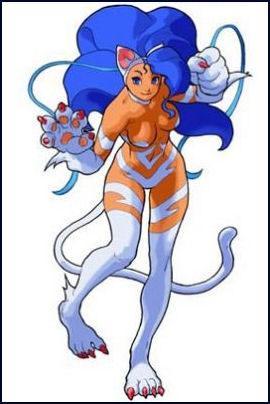
Felicia, a popular game
character in Japan Japan is the world’s second largest video game market after the United States. Sales in the Japanese gaming industry — which includes arcade, computer games, consoles and software games — in 2006 was $12.5 billion, the highest ever The Japanese gaming industry is much bigger and more profitable than the Japanese film industry. In the United States, computer and video games outsell movie tickets by $10.5 billion to $7.7 billion and is about equal to the $10.8 billion DVD and videotape tape market.
The gaming industry generates about $30 billion a year in revenues. It began with the invention of Pong and then Pac-Man (See Below) and Space Invaders. The first bestselling consoles were made by Atari, then by Sega, then by Nintendo, then by Sony. Later Microsoft entered the arena. Nintendo is the dominant maker today. In Japan the manga, anime, video game, television and media industries are all interrelated. Many popular manga characters find their way into video games and anime DVDs.
Japanese companies once dominated the video game industry. That is still largely the case with Nintendo and Sony dominance in the console industry but is no longer the case with software and games. Video game companies make their money on software. The hardware units often lose money and are regarded mainly as platforms for selling the software. Video games with Japanese themes such as Tenchu and Way of the Samurai are hot sellers worldwide.
The Tokyo Game Show is the world’s largest computer entertainment show. It is held in September or October near Tokyo at the Makuhari Messe convention center in Chiba. The first two days are restricted mainly to people in the gaming industry. The last two days are open to the public. Over 900 games were displayed and 200 groups and companies had exhibits at the 2007 event. Around 200,000 people visit during its four-day run.
The Japanese video game industry has been slumping recent years. At the Tokyo Game Show in 2009, there were only 180 booths down from 209 the year before. Attendance was also down. Many of the games were sequels. Foreign companies are increasingly grabbing up a larger share of the market. A total of 207,647 people showed up for the four-day Tokyo game Show in 2010, up from the 185,030 that came in 2009. The gaming industry — both hardware and software — in the United States declined by 10 percent in 2010. In Japan sales declined by 16 percent in the first half of 2011, according to the magazine publisher Enterbrain, but are expected to pick up when Nintendo and Sony release new products.
The use of “majikon” “the “magic computer” device that enables portable game players to run illegally duplicated game software — is believed to have cost software-makers and others at least ¥350 billion in lost revenues. The adapter works by disabling control functions in devises that are supposed to thwart unauthorized software use. The spread of the adapters has also led to the emergence of computer viruses targeting users of the devises that can in some cases grab personal information from the users’ computers.
Websites and Resources
Good Websites and Sources: Japan Video Games japanvideogames.com ; Krazy World of Manga, Anime and Video Games aboutjapan.japansociety.org ; Photo Blog of Video Games thefastertimes.com/videogames ; Academic Paper on Video Game Clustering in Japan pdf file isc.hbs.edu/pdf ; Video Game Subculture and Addiction allacademic.com ; Mushi King — King of the Beetles mushiking.com ; Love and Berry — Dress Up and Dance loveandberry.com ; Book: “Fun Inc.: Why Games are the 21st Century’s Most Serious Business” by Tom Chatfield (2010 Virgin Books).
Arcades Arcades in Japan cardhouse.com/travel/japan/arcades ; Arcade Hell kotaku.com/263545/sex-gambling-but-not-games-in-japanese-arcade-hell ; New York Times on Japan’s Arcade Slimp nytimes.com ; Video Game Companies Square Enix square-enix.com ; Konami konamijpn.com ; Sega-Sammy segasammy.co.jp ;
Otaku Urban Dictionary urbandictionary.com ; Danny Choo dannychoo.com ; Otaku Dan Blog otakudan.com ; Otaku Generation Blog generationotaku.net ; Dumb Otaku dumbotaku.com Otaku story in the Washington Post Washington Post ; Otaku History Wikipedia article Wikipedia ; Academic Pieces on the History of Otaku cjas.org ; cjas.org and cjas.org ; Early Piece on Otaku (1990) informatik.hu-berlin.de ; Man, Nation, Machine informatik.hu-berlin.de ; Otaku from Business Perspective nri.co.jp/english ; Otaku Sites The Otaku, Anime and Manga Portal and Blog theotaku.com ; Otaku World, Online Anime and Manga fanzine otakuworld.com ; Otaku Magazine otakumag.co.za ; Otaku News otakunews.com ; Danny Choo dannychoo.com ; Spacious Planet Otaku Blog spaciousplanet.com ; Otaku Activities Maid Cafes stippy.com/japan-culture ; Male Maid Café yesboleh.blogspot.com ; Akihabara Book: “The Best Shops of Akihabara — Guide to Japanese Subculture” by Toshimichi Nozoe is available for ¥1,000 by download at http://www.akibaguidebook.com Akihabara Murders : See Government, Crime, Famous Crimes . Websites: Picture Tokyo picturetokyo.com ; Akihabara News akihabaranews.com ; Akihabara Tour akihabara-tour.com ; Otaku story in Planet Tokyo planettokyo.com
Links in this Website: SPORTS AND RECREATION IN JAPAN (Click Sports, Recreation, Pets ) Factsanddetails.com/Japan ; BICYCLES, HORSES, BOATS AND GAMBLING IN JAPAN Factsanddetails.com/Japan ; PACHINKO Factsanddetails.com/Japan ; GAMES IN JAPAN Factsanddetails.com/Japan ; TOYS IN JAPAN Factsanddetails.com/Japan ; VIDEO GAMES IN JAPAN Factsanddetails.com/Japan ; SONY VIDEO GAMES Factsanddetails.com/Japan ; NINTENDO Factsanddetails.com/Japan
History of Video Games in Japan
Video game media have already been around for quite some time and today they have grown to rival both the music and movie industries as money-making branches of entertainment. A milestone event in the history of Japanese video games was the debut of the “Space Invaders” game in 1979. The video apparatus — positioned horizontally, with an upward-facing screen set into the table — led to widespread popularization (indeed a social phenomenon) that included the opening of Invader Houses. As part of the recent video game nostalgia boom, “Space Invaders” has reappeared in some game centers. [Source: Web-Japan, Ministry of Foreign Affairs, Japan]
“In 1983, when the first sales of game systems such as Nintendo and other models permitted video games to enter the home, a full-fledged video game culture got under way. Games that previously could not be enjoyed unless one went out to a game center or a tea shop and slotted 100 yen for each game, could now be played without having to spend so much time or money. Such games soon won the almost fanatical devotion of many children. The games comprise diverse genres, including action games, which stimulate the reflex nervous system; role playing games, in which the player participates by assuming certain roles; and simulation games, where the player may be made to feel that he or she is driving a car, for example, or piloting an airplane.
“A video game that captured the hearts of many small children in 1996 and 1997 was “Pokemon” (“Pocket Monsters”). It involved capturing, in a certain order of succession, 151 types of monsters hiding in prairies or forests. These creatures are then tamed and raised. The game was the genesis of the Pokemon phenomenon that eventually expanded to include trading cards, “manga”, several television animation series, and many feature-length animation films.
“The start of the 21st century saw video games further diversify. First, online games became able to allow an unspecified group of players to interact online and enjoy the game simultaneously. The player-experience was enhanced by the chance to play against people never met before, or to cooperate with them to defeat the enemy, as well as the chat function to communicate with each other in the games. In addition, next-generation games were released one after the other, including games with sports or training features where the player could play by moving a remote control or by moving the body while standing on a balance board. Others featured advances such as 3D screens.
“The computer game bonanza has not merely increased sales of game hardware and software. Background music used for certain games has joined more conventional musical hits to rank on the charts of bestselling CDs, and best-selling books have come to include “koryakubon”, manuals for the playing and solving of various video games. These are examples of ways in which game systems have had multimedia effects while coming to occupy a significant place among Japan’s culture industries. The fact that such industries have also been successful abroad (most notably in the United States) is something that marks a turn of events for Japan, which has been a diligent importer of foreign culture since opening up to the outside world in the Meiji era. The release of a new video game console by a major company like Sony Computer Entertainment Inc. or Nintendo is a huge event not only for game fans but also for the global consumer electronics industry.
Pac-Man and Its Inventor
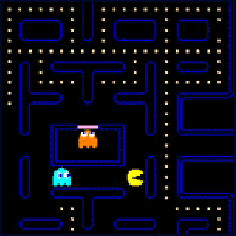
Pac-man is regarded as the godfather of the $30 billion-a-year gaming industry. It was invented by Toru Iwatani, a 25-year-old programmer with the Namco game company, in 1980. He was inspired by a Pizza in a Shakey’s restaurant that had one piece removed and motivated by a desire to create a game that might interest girls after visiting arcades filled with games for boys that involved killing and fighting. [Source: Leo Lewis, The Time, August 2005]
Itawani told the Times of London, “So there I was wondering what sort of things women would look for in a video game. I sat in cafes and listened to what they were talking about: mostly it was fashion and boyfriends, Neither of those was really the stuff for a video game. Then they started talking about food — about cakes and sweets and fruit — and it hit me that food and eating would be the things to concentrate on to get girls interested.” And with that idea in mind he came up with Pac-Men chomping their way through a maze, pursued by ghost inspired by an anime ghost called C-Taro.
Pac-man continues to be played today and is still featured in some arcades, By some estimates it has been played more than 10 billion times. Its appeal has been attributed to its human rather than mechanical quality: the act of munching and the cartoonish pac men and ghosts
Iwatani created Pac-an with a team of six developers. He told the Time of London they were given a relatively free hand because managers in his company were relatively ignorant about games and the market. Iwatani continues to work for Namco out of dingy office in Yokohama. Pac-man became a merchandising as well as gaming phenomena, generating lunch boxes, sweatshirts, a hit song and a Hanna-Barbara cartoon that earned a 56 percent prime time rating. The game earned Namco $100 million. For his efforts Iwati was promoted to supervisor level and still lives in a house too small to accommodate a Pac-Man arcade game..
Pac Man eats dots (they’re supposed to cookies), ghosts and fruit, while trying to dodge Blinky, Pinky, Inky and Clyde. On its way to becoming a global video came and cultural icon, it inspired a single that reached No.9 on the U.S. charts in 1982 and was named the most successful coin-operated game machine by the Guinness Book of World Records from its launch to 1987 when 293,822 games were installed around the world. France released a Pac-Man stamp. For a while a city in Iowa renamed it’s a park Pac man park. [Source: Cameron McLauchlan, Daily Yomiuri, October, 2010]
The game was originally called “Puck man” but the name was changed to “Baby, Pac-man” out of concern that vandals might deface the “P” into an “F”. The highest possible score is 3,333,360. The record for the shortest time to reach this score is 3 hours, 42 minutes and 22 seconds. The original plan was for the game to be slower but during tests — when the speed was doubled — the testers found the game was more fun. Pac Man is still thriving, A new 3-D television series is currently being made.
Gaming Companies
Capcom, Square Enix and Namco Bandai are the biggest software and game makers in Japan. Many of the games are made for the Japanese market and don’t necessarily transfer well to other cultures
Square Enix makes “Final Fantasy”, “Kingdom of Hearts”, and “Dragon Quest”. The company goes through great lengths to make games and characters that appeal to local tastes in the countries the games are marketed. In August 2005. Square Enix it bought Taito, the create of “Space Invaders”.
Square Enix is Japan’s top maker of role-playing video games. Final Fantasy was created by Japanese video director Hironobu Sakaguchi. For a long time it was the best selling franchise on Sony PlayStation. Sakaguchi was also behind the “Final Fantasy” film.
Osaka-based Capcom produced the popular “Monster Hunter” and “Biohazard” series.
Namco Bandai is the maker of “Pac-man” (See Below) and the “Gunslinger” and “Dragonball Z” games and the No. 2 maker of toys and games in Japan after Sega Sammy. Namco developed the Ridge Racers as well Pac-Man. It also operates game arcades and theme parks in Japan. In May 2005, Bandai bought Namco in a $1.7 billion deal.
Konami is another large video game marker. The “Metal Gear Solid” has sold more than 22 million copies. It is was designed by Hideo Kojima and inspired by the 1863 film “The Great escape”.
Microsoft’s Xbox 360 sold very well in the United States but didn’t sell so well in Japan.
In 1994 Panasonic invested a huge amount of money to develop a multi-media console 3DO Real that was largely ignored by the market. The firm pulled out of the video game market three years later. In 2010 Panasonic decided to take another shot at gaming, introducing the Junge hand-gled device, developed in Silicon Valley by a Panasonic affiliate. Panasonic made the decision to enter the market in part because it is now easier to develop and market devices and software than it was in the past.
Sega
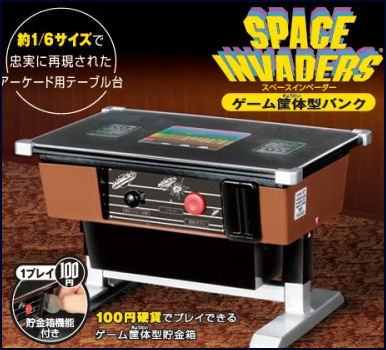
Space Invaders bank Sega Sammy is the No. 1 maker of toys and games in Japan. It was formed in 2004 from a merge of the video-game maker Sega and Sammy, the largest manufacturer of pachinko and gambling machines in Japan. Based in San Francisco, Sega it made games and ran arcades in Japan. It was a major console maker before Nintendo and Sony became dominant.
SEGA (SErvice GAmes ) was founded after World War II by entrepreneurs from Hawaii who felt there was money to be made by providing pinball machines and other ways for American servicemen stationed in Japan to amusement themselves. The company, founded by three Americans, was originally called Standard Games but it changed its name to SEGA when it moved its headquarters to Tokyo in 1951.
Sega share of the console market fell to 1 percent after the release of its unpopular and complicated Saturn console in 1996. Its Dreamcast console also proved to be a bust. Sega ended up abandoning the console after that and concentrating strictly on games.
Sega developed Musiking and Love and Berry (See Below). Seaman — a game that involves growing prickly and rude fish with a human head — was popular in Japan for a while.
In June 2011, the BBC reported: “Sega has confirmed that the personal data of 1.29 million of its customers was stolen in an attack on its systems. It comes after the computer games firm said on Friday that e-mail addresses and dates of birth stored on the Sega Pass database were accessed by hackers. However, Sega continues to say that payment information, such as credit card numbers, remained safe.” Sega spokeswoman Yoko Nagasawa said: "We are deeply sorry for causing trouble to our customers." [Source: BBC, June 19 2011]
In an e-mail sent to Sega Pass users on Friday, the company wrote: "Over the last 24 hours we have identified that unauthorised entry was gained to our Sega Pass database. "We immediately took the appropriate action to protect our consumers' data and isolate the location of the breach. We have launched an investigation into the extent of the breach of our public systems."
Sega explained that it had reset all passwords and urged customers to change their log-on details on other services and websites where they used the same credentials. It added that password details had not been stored in plain text, suggesting that they may have been secured by some kind of encryption.
Sega is the latest in a line of games companies to suffer hacking and denial of service attacks on their online services. The hacker group Lulz Security, which has been involved in a number of high profile attacks, including one against Sega rival Nintento, has denied involvement in the Sega case. Instead it showed some sympathy for the company on its Twitter feed. "We want to help you destroy the hackers that attacked you. We love the Dreamcast, these people are going down," it said.
Dating Games, Love Plus and Princess Maker
Dating simulation games have been compared to “shojo” manga (girls comic books) or Harlequin romances except that players can interact with the story deciding which way the plot will evolve or what will happen to a particular character. The target audiences of the games are teenage girls and young women but the games, it is hoped, will also appeal to middle-age women as the shojo manga do.
“Duel Love” is a virtual boyfriend game by Bandai in which the tip of a stylus becomes a hand grasping a wash cloth that can be used to wipe sweat from the torso of reclining virtual body. “Harukanaru Toki no Naka de” (“In Distant Time”) is a fantasy series in which a modern high school girl travels to another world, where she becomes a shrine maiden fighting along side eight male characters protecting a city resembling Kyoto.
“Angelique” is game with characters designed by cartoonist Kairo Yura.. In it high school girls have been nominated to be queen of a cosmos and the player, as one of the girls, competes against rivals to prove her governing skills with help of nine cute male guardians. The player tries to become queen and gets romantically involved with one of the guardians.
Companies that make these games hope to not only make money from the games themselves but also from spin-off comics, merchandise, CD audio dramas, TV animes, films, plays, radio broadcasts and live events,
Creepy Japanese computer game popular in the 1990s included Princess Maker, a game in which a beautiful 10-year-old girl is adopted by a "father" (the game player), who can order her to anything he wants, even sunbathe in the nude; Tokimeki Memorial, a game in which a player can win the girl of his dreams in an imaginary high school by performing tasks that require at least 15 hours of game-playing to fulfill. Princess Maker was introduced in 1991 and had sold more than 200,000 copies by 1996.
Psychiatrist and game therapist Rika Kayama told Time, "These types of games appeal to the majority of men today who don't fit into society where one has to be handsome and outgoing to attract girlfriends."
On playing the girlfriend game “Love Plus” otaku columnist Kanta Ishida wrote: “the real fun starts...as soon as you get a girlfriend...The game begins to work in concert with the built-in calendar of the DS device, allowing a player to spend every day with his new girlfriend...The key to becoming closer to her is to have more conversations with her and to learn to kiss her well but only with a stylus. (You might be smirking now, but, believe it or not, it really does make you heart beat faster).”
“The girlfriend, in fact, is more dedicated than a real one would be. She changes her clothing and hairstyle depending in ger boyfriend’s tastes. Her character also changes according to the way he treats her...because sometimes she asks you to literally speak words of love, using a built-in microphone. It is no wonder some married men claim they are unable to play it at home.”
Japanese Arcades
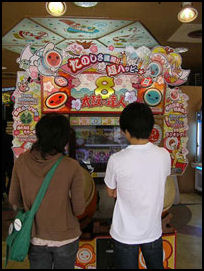
arcade game The amusements found at Japanese game centers generally fall into five categories: 1) crane games such as “UFO catcher” in which players try to pick a prize such as a stuffed animal by manipulating the grasper of a small crane; 2) photo sticker machines such as “Print Club”; 3) music-based games such as “Dance Revolution” ; 4) trading-card games such as “Mushi King”; 5) vintage games such as “Space Invaders” and “Elevator Action”; and 6) the driving and shooting games that have been the fixture of arcades as long as anyone can remember.
Before arcade and video games took over the Japanese equivalent of pinball machines were ¥10 game machines that were often placed at department stores and Mon-and Pop candy stores. In one game players use levers to try to maneuver a ¥10 coin into a hole. Other include a dice throwing game and a rock-scissors-paper game.
SEGA (SErvice GAmes ) was founded after World War II by entrepreneurs from Hawaii who felt there was money to be made by providing pinball machines and other ways for American servicemen stationed in Japan to amusement themselves. The company, founded by three Americans, was originally called Standard Games but it changed its name to SEGA when it moved its headquarters to Tokyo in 1951.
Book: “Arcade Mania: The Turbo-Charged World of Japan’s Game Centers” by Brian Ashcroft with Jean Snow (Kodansha International, 2008)
Japanese Arcade Games

Mushi King card Japanese arcades are a $6.9 billion business. Large operators include Sega Sammy Holdings and Namco Bandai
Among the popular arcade games found in Japan driving games, fighting games, dancing games, game that feature battles between insects, goldfish scoops and games in which players use miniature cranes to pick up live lobsters, gold fish or stuffed Winnie the Poohs. Some animal rights groups have protested about the game with live lobsters.
Konami's Dance Dance Revolution was a big hit at arcades in Japan in the 1990s. Describing a 19-year-old young man using the device Tim Larimer wrote in Time. "He plops two 100 yen coins into a slot, taps his game choice on a video display and waits for the music to begin. Standing on a small platform in front of the screen he tries to match the moves of the digitalized dancer. 'Perfect!' the screen's message announced as he furiously stamps on four large neon squares. 'Great!' it assures him.”
Mushi King
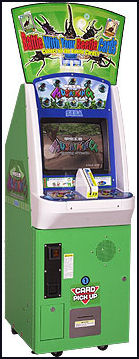
Mushi King
arcade game The biggest video game craze in the mid 2000s was “Mushi King: the King of the Beetles” — a game that involved separately buying cards with images of large beetles’such as the Giraffe stag-beetle, the saw-tooth stag beetle or the Thailand five-horned beetle — on them and various information and feeding them into an arcade machine that show 3-D images of the beetles battling to the death.
Mushi King (“Bug King”) was introduced in 2003 by Sega who made money both from the selling of the cards and from the machines that played the cards. The game and cards were especially popular with preteen boys who fed cards into machines at toy stores and arcades. As of March 2007, 420 million cards and half million copies of the software that allowed the game to be played at home on Game Boy or PlayStations had been sold. At its peak more than 13,000 Mushi King arcade machines were in 5,200 locations.
There are 856 Mushi King cards, each one with a real beetle species. They sell for ¥100 a piece and are available only from the arcade machines. Each card carries a number that measures the beetle’s strength and stamina, which can be enhances with supplemental special “skill” cards. The beetles use moves like those found in profession wrestling. Each has a special Finishing Attack such as a Running Cutter, Tornado throw or Rolling Smash which it use to finish off an opponent.
Cardholders can battle other cardholders or beetles on the machine. The battles begin after the machine scans the bar codes on the cards. Players chose when and how to attack and the outcome is based as much on their skill and the values on their cards.
Mushi King is a make-believe version of an insect fight staged in a small ring such as those held between crickets in China. There is a television animation series that goes along with the game as well as merchandise such as lunchboxes and gloves.
Love and Berry
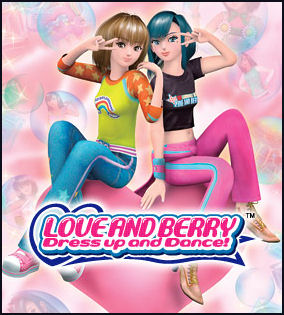
Love and Berry “Love and Berry Dress Up and Dance” was popular game with kindergarten and primary school girls. Like Mushi King it centered around players purchasing cards that could be fed into arcade machines
Players earn points by dressing up two witches, Love and Berry, and getting to dance. Players chose how the witches will prepare for a dance by feeding “Oshare Maho” (“magic makeover”) cards with hairdos, dresses and shoes into the machines. Participant can earn points by rhythmically pushing buttons as the witches dance with the winner being the one who is most stylish.
The machine charge ¥100 for each card and playing of the game. The machine were installed in shopping malls and arcades in October 2004. As of March 2007, 240 million cards had been sold and a total of 164 cards, with hairdos, clothes and shoes, had been issued with the 88 cards of the 2005 Spring and Summer Collection being auctioned online for ¥10,000. A similar online girls game features Japanese schoolgirls competing in dancing contests.
Explaining the appeal of these games, a Japanese fairy tale author old the Yomiuru Shimbun, “The Love and Berry game is a competition for fashion sense turned into numerical terms.” He said there were similarities to exchanging money and because of the low birth rate even little kids are exposed to designer clothes: “So, even little girls think they can fix themselves up easily.”
The mastermind behind Love and Berry and Mushi King is Hiroshi Uemura, the head of a game development team at Sega that was on the verge of being shut down before the success of Mushi King, which was designed to be a game that parents and children could enjoy playing together.
Decline of Arcades in Japan
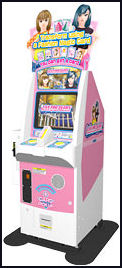
Love and Berry
arcade game Japan’s arcade business has been suffering as result of competition from video games, with Sega Sammy Holdings and Namco Bandai both closing down a number of their arcades. . The first blow occurred after the introduction of Sony’s Playstation. A bigger blow occurred with the arrival of Nintendo’s Wii, which has robbed arcades of the one advantage they had over video games — being the best place to play active games.
.Competition is also come from flat screen televisions and new consoles that have cutting edge graphics and sound that can replicate the arcade experience at home; and computers, cell phones, the Internet and hand-held consoles that offer people the chance t play a wide variety of games almost anytime, anywhere. High gas prices and crackdowns on loitering youths have also contributed to the decline.
Many people are just getting tired of arcades. One 15-year-old boy told Reuters: “Arcades are expensive, noisy and filled with cigarette smoke,” adding that he would rather go to a theme park. Analysts say that arcades will make a come back if a new “big thing” comes along that can’t be played at home. Some arcades are trying to win back customer by having visits by Ultraman and other events.
New Games and Software
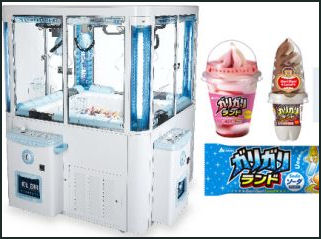
ice cream UFO catcher In the late 2000s there was some outrage over a video game that featured the rape of two girls and their mother with players raping the girls, getting them pregnant and securing abortions, scoring points with each violent act committed against the females The game was developed by a Yokohama-based game software maker. International protests forced Amazon and others to stop selling the game but the game continued to be sold in Japan because sanctions placed on the game were only voluntary. A number of similar games also continue to be sold, made and developed.
Voice synthesizer software which can make a virtual idol sing a song in a feminine voice have become very popular. The trend began in August 2007, when a device featuring a virtual idol named Hatsune Miku was introduced that sings after lyrics and melodies are entered into a computer. The software has helped some up an coming groups write songs, get exposure and secure recording contracts.
Highly-touted games introduced in 2010 included Sony’s “Gran Turismo 5" and “God of War III”, Capcom’s “Darkside Chronicle”, the Bandai fighting game “Tekken 6", the Sega yakuza adventure “Ryu Gotoku 4" and Konami’s “Silent Hill: Shattered Memories”.
“Dragon Quest” by Square Enix is a role playing game in which players journey through a fantasy land fighting monsters and solving problems. Between its introduction in 2009 1986 and 2009, it had sold 47 million units.
Capcom’s “Monster Hunter “has been one of the most popular video games ever in Japan. The PlayStation Portable version sold over 4 million copies in first month after it was introduced. Designed by Ryozo Tsujimoto, a player plays the role of a hunter who searches through various landscapes for monsters to kill. Along the way he can collect mushrooms, nuts and metals and use these to create weapons, armor and potions. One survey found that 15 to 20 percent of those who played it were women.
3-D anime and games were in the spotlight at the Tokyo anime fair in 2010. Tom Bake wrote in the Yomiuri Shimbun, “Some effects were simply good, and others were mind-blowing. Inside the promotional booth for “Garo: Red Requiem”, an upcoming TV adventure series about demon-fighting knights, visitors donned special glasses through which they could see a long gleaming sword coming right at them (via a flying martial arts kick) and even a geyser of champagne coming right at them (in slow motion, no less). “
Portable Game Machines Versus Smartphones
With smartphones and tablets from Apple and others eating into the market for portable gaming devices, Sony and Nintendo desperately need a blockbuster product to boost sales and profit. Matt Richtel and Hiroko Tabuchi wrote in the New York Times: “For video game fans, carrying around a portable game player from Sony or Nintendo has become less of a necessity now that they can play games on their increasingly sophisticated smartphones. But in 2011, the game-gadget makers are intent on working their way back into the world’s pockets. In 2010, “overall sales of software for hand-held devices like the DS and Sony’s PlayStation Portable in the United States fell about 19 percent, according to the market research firm NPD. No wonder, analysts say, given not just the growth in popularity of smartphones, but also the fact that games for phones cost just a few dollars, compared with, say, $30 for a PSP title.” [Source: Matt Richtel and Hiroko Tabuchi, New York Times, January 2, 2011]
“The game makers must persuade consumers to add another gadget to a pile that already includes phones and other game-capable touch-screen devices and tablets. Apple’s iPhone and iPod Touch, in particular, have turned out to be major game platforms.” “Mobile phones and the iPod Touch have killed the hand-held game business,” Michael Pachter, an industry analyst at Wedbush Securities, told the New York Times. He said particular damage had been done at the high end, where parents and children are opting for an iPhone rather than a PSP, and at the low end, where consumers are choosing the iPod Touch over a DS — and then spreading out $100 over 50 games, rather than three or four games for dedicated devices.
Evan Wilson of Pacific Crest Securities said the 3DS and the next version of Sony’s PSP would be hard-pressed to reproduce the success of the current models.”Given the shifts in the market, it’s nearly impossible to sell as many 3DS as they did DS, and nearly impossible for Sony to sell as many of the next PSP as they did the PSP,” he said.
In the six years since the DS was introduced, Nintendo has sold around 132 million units, compared with sales of around 63 million for the PSP. And sales are not yet played out. During Thanksgiving week, Nintendo said it sold 900,000 units in the United States, down around 10 percent from the same period a year ago. By comparison, Apple said that through July, it had sold 100 million iPads, iPod Touches and iPhones since the first iPhone was introduced in 2007. Mobile phone adoption among children has soared 68 percent in the last five years, according to the Federal Communications Commission.
Sony executive Kazuo Hirai told the New York Times he acknowledges the popularity of more casual games on phones, but he argued that game-specific devices like the PSP appealed to a player interested in a deeper, more sophisticated game. “The games being played on Android and Apple platforms are fundamentally different,” Mr. Hirai said. And he argued that game-specific devices could offer better game play with buttons and other physical controllers.”You can definitely play immersive games better with physical buttons and pads,” Mr. Hirai said. “I think there could be games where you’re able to use both in combination.”
Richtel and Tabuchi wrote in the New York Times: “For example, in the PSP action game Metal Gear Solid: Peace Walker, users manipulate a joystick to move the soldier around, hold down another button to draw and aim his gun, hit a separate set of buttons to adjust viewing angles and use a directional, cross-shaped pad to crouch and reload. On top of that, a button on the shoulder of the console fires the gun. Developers of games played on a touch screen like the iPhone’s, on the other hand, have had trouble creating controls for some types of games. They say even simple titles like Super Mario Bros. would not translate well to the iPhone, for example.”
Gamemakers are also producing new versions of popular games for tablets such as the Ipad. Hiroko Tabuchi wrote in the New York Times, “Once solely focused on creating video games for dedicated consoles like the Wii from Nintendo and more recently for cellphones, the Japanese game developer Konami Digital Entertainment released an iPad version of its popular Metal Gear Solid Touch this year. Another game maker, Capcom, says it will reformat its BioHazard 4 for the iPad.”
Image Sources: 1) 3), 9), 15) xorsyst blog 2) 10), Japan Visitors 4) 7) Hector Garcia, 5) 8) Japan Zone, 11), 12) Mushi King official site 13) 14) Love and Berry official site
Text Sources: New York Times, Washington Post, Los Angeles Times, Daily Yomiuri, Times of London, Japan National Tourist Organization (JNTO), National Geographic, The New Yorker, Time, Newsweek, Reuters, AP, Lonely Planet Guides, Compton’s Encyclopedia and various books and other publications.
Last updated January 2013
